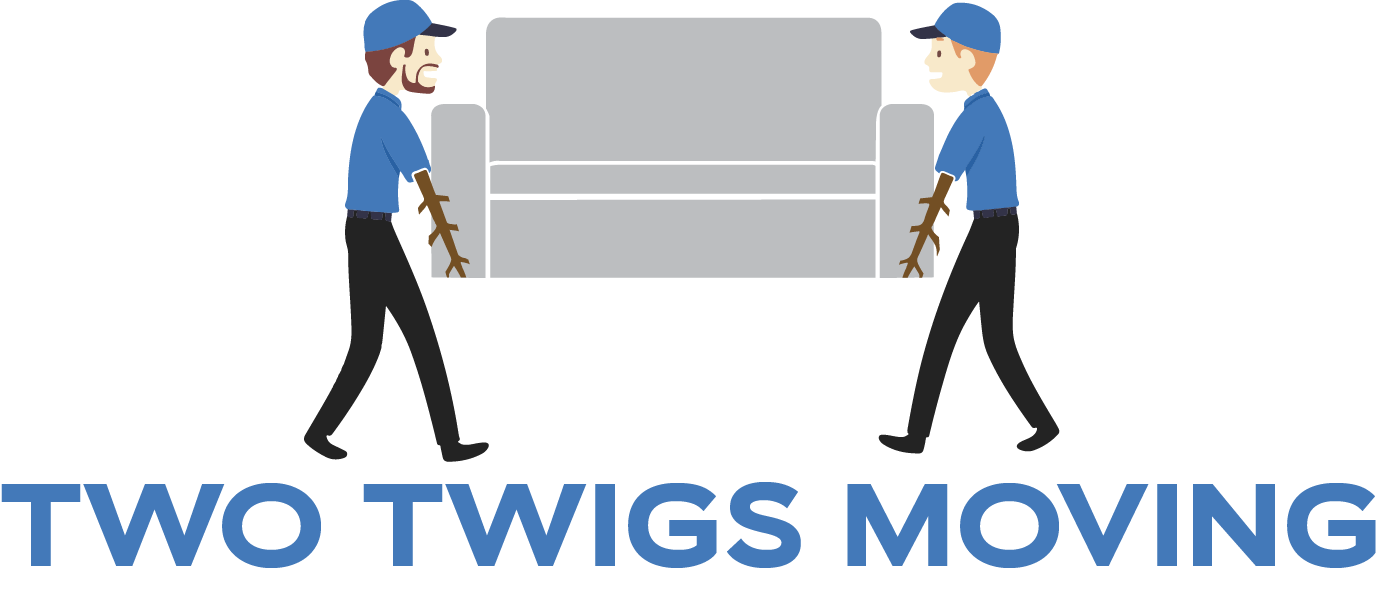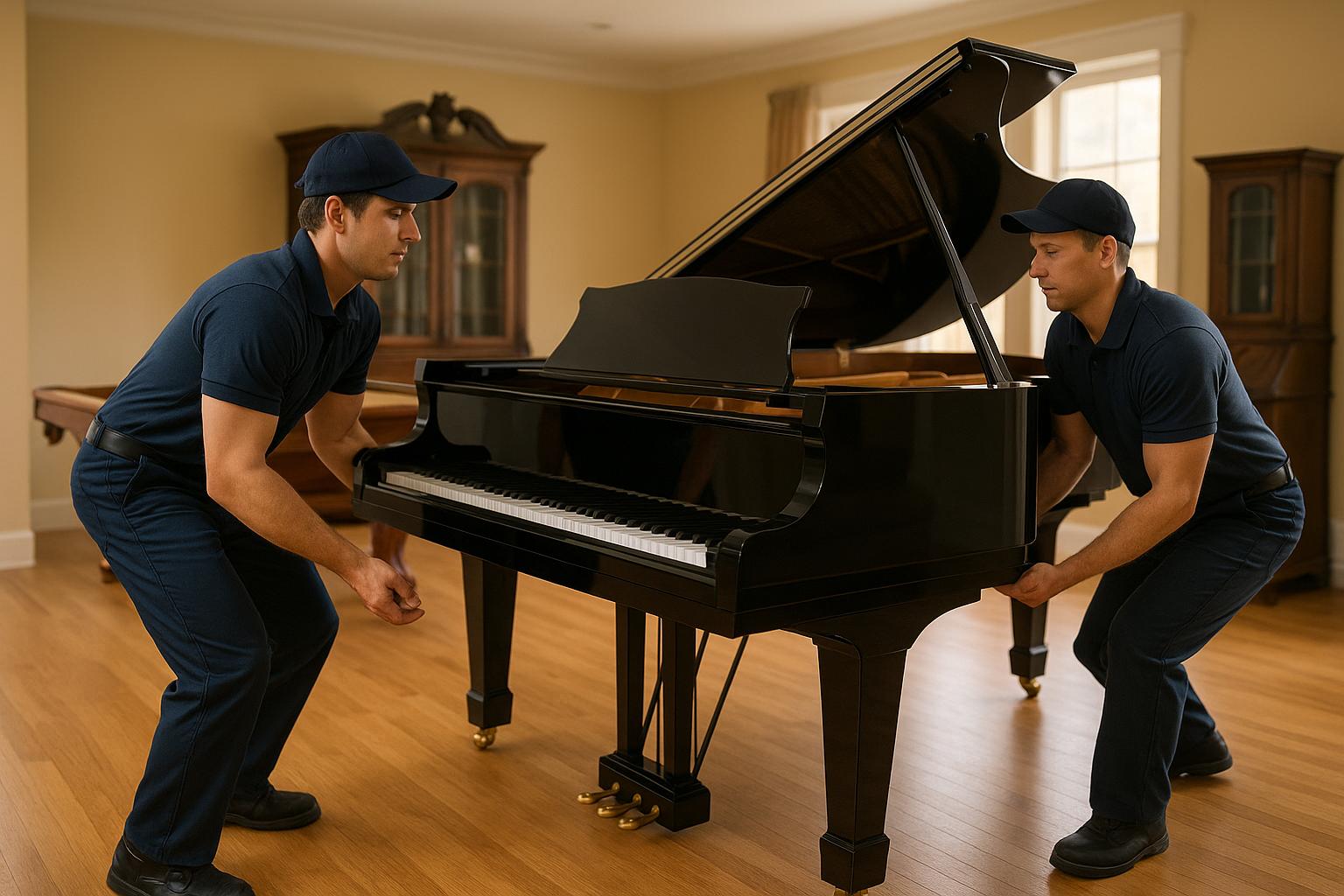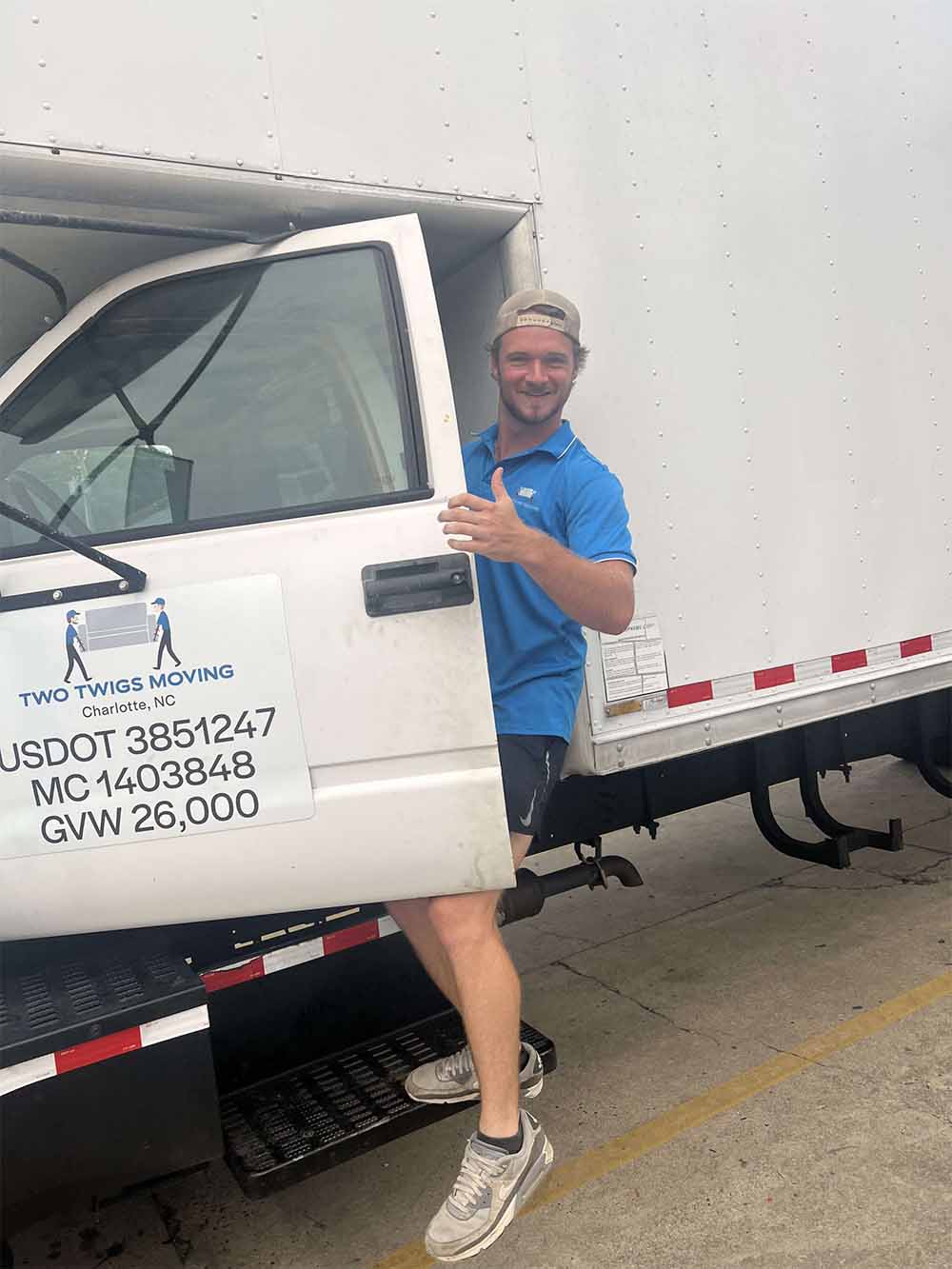Moving heavy and fragile items like pianos, pool tables, safes, and antiques requires careful preparation, proper tools, and precise handling. These items are not only physically challenging to transport but also hold significant monetary and sentimental value. Here’s what you need to know:
- Pianos can weigh 500–1,200 pounds, with prices ranging from $3,000 to over $100,000. Improper handling can damage their intricate mechanisms.
- Pool tables often weigh over 1,000 pounds. Misalignment during transport can require expensive recalibration.
- Antiques and safes demand extra care due to their delicate construction or weight.
Key steps include:
- Preparation: Measure items and pathways, gather tools like dollies and moving blankets, and plan the route.
- Disassembly: Remove and label parts, wrap fragile surfaces, and store hardware securely.
- Transport: Use proper lifting techniques, secure items in the truck with straps, and drive cautiously.
- Reassembly: Follow photos and labels to reassemble, test functionality, and make adjustments.
Local challenges in cities like Charlotte, Charleston, and Greenville – such as narrow streets or historic architecture – can complicate moves. Professional movers like Two Twigs Moving offer expertise to navigate these obstacles safely.
Moving specialty items is not just about transportation – it’s about ensuring they remain intact and functional throughout the process. For complex moves, hiring professionals is often the safest choice.
Why Specialty Items Need Special Moving Methods
Everyday items can usually be moved with standard techniques, but specialty items like pianos, pool tables, and antiques require a more tailored approach. Their unique construction, uneven weight distribution, and high monetary or sentimental value mean they need extra care and precision.
Take pianos, for example. Their intricate mechanisms can be damaged by even the slightest jolt. Pool tables, on the other hand, rely on a perfectly level surface – any misalignment during the move can throw off the balance and require costly recalibration. These challenges make it clear: moving specialty items isn’t just about transportation; it’s about safeguarding their functionality and integrity at every step.
Main Risks and What to Consider
Handling specialty items improperly isn’t just a risk to the items – it can also lead to injuries or property damage. A lack of proper technique can harm movers, scratch floors, or damage walls. Beyond that, incorrect disassembly and reassembly can affect how these items function, potentially leading to expensive repairs.
For instance, disassembling and reassembling a pool table demands precision, while pianos often need tuning after a move due to shifts in alignment. Environmental factors like temperature and humidity changes can also impact materials like wood and fabric, making careful planning even more critical.
Moving Challenges in Charlotte, Charleston, and Greenville
Each city presents its own set of hurdles when it comes to moving specialty items. In Charlotte, urban living often means dealing with tight parking, elevators, and narrow doorways in multi-story buildings. Charleston’s historic charm comes with its own difficulties – think narrow, winding streets and older architecture that can make maneuvering larger items tricky. Two Twigs Moving has developed techniques designed specifically for Charleston’s historic districts.
Meanwhile, Greenville’s varying elevations and narrow streets require extra caution. Sudden weather changes in the area can also pose risks to delicate items, making it essential to account for these variables during the move.
Choosing experienced movers who understand these local challenges can make all the difference. With the right expertise, proper planning, and attention to detail, specialty items can be moved safely and efficiently. The next section will dive into how these processes come together for a seamless move.
How to Prepare and Plan Your Specialty Move
Getting ready for a specialty move requires more than just packing boxes. Start early by assessing your items, gathering the right tools, and mapping out each step. This careful preparation helps protect your belongings and ensures everything goes smoothly.
Evaluate Your Items and the Space They’ll Travel Through
Take a close look at the size, weight, and condition of each item. For example, moving a grand piano is a completely different challenge than moving an upright one. Similarly, pool tables made from various materials can require unique handling techniques.
Measure your items carefully, noting their height, width, and depth. Then, examine the spaces they’ll need to pass through, like doorways, hallways, and staircases. Tight corners or steep stairs can complicate things, even if the item fits through a door. Knowing this in advance lets you plan for any tricky spots.
Essential Tools and Equipment
Stock up on the gear you’ll need, such as heavy-duty dollies, moving blankets, and load-rated straps. Keep disassembly tools handy – like a socket wrench set, cordless drill, and rubber mallet. Use small containers to store screws, bolts, and other hardware, so nothing gets lost in the shuffle. Having these tools ready minimizes delays and keeps your move on track.
Create a Step-by-Step Moving Plan
Your plan should account for local factors, especially if you’re in cities like Charlotte, Charleston, or Greenville. These areas come with their own challenges, such as tight urban layouts or unpredictable weather. Outline each stage of the move, from disassembly and packing to transport and reassembly. Label all components and take photos to make reassembly easier.
When planning your route, think about traffic patterns, parking restrictions, and local regulations. Moving during off-peak hours can save time and stress. If parking is limited, secure permits ahead of time. Companies like Two Twigs Moving specialize in coordinating these details for clients in Charlotte, Charleston, and Greenville, ensuring local logistics are handled effectively.
Finally, get both the starting and ending locations ready. Clear pathways, protect floors, and prepare for any weather surprises to avoid last-minute issues. A little preparation goes a long way in making your specialty move a success.
How to Pack and Disassemble Specialty Items
Disassembling specialty items correctly is key to preventing damage and avoiding unexpected costs. Each type of item has its own process and packing needs, so it’s important to follow the right steps.
Taking Apart Pool Tables and Pianos
Pool tables require a specific disassembly process to protect their delicate components. Start by removing the ball pockets, which are typically stapled or screwed into place. Next, unscrew the bolts holding the rail cushions. To make reassembly easier, take photos as you go to document how everything fits together.
The felt is an especially fragile part. If it’s glued down, you may need to cut it, but stapled felt can often be saved and reused. Carefully wrap the felt and store it in a dry, safe location. Use masking tape to secure and label each part for clarity.
The slate pieces are the heaviest and most challenging to handle. Most pool tables have three slate sections, each weighing 150–200 pounds. These are secured to a wooden frame with screws. You’ll need at least four people to lift and move each piece safely. Wrap the slate in moving blankets and transport it in an upright position to avoid damage.
Pianos, on the other hand, vary by type. For upright pianos, wrap the entire instrument in padded blankets and secure them with straps. If possible, remove the legs to make it easier to navigate tight spaces.
For grand pianos, a more detailed disassembly is required. Begin by removing the music rack, bench, and pedal assembly. Then, detach the legs, which are usually secured by bolts or pins. The lid should be handled with extra care, as it’s often the most visible and fragile part. Wrap it separately in thick blankets and clearly mark it as "fragile."
These steps ensure that all components are protected and ready for safe transport.
How to Protect Fragile Surfaces
Wood finishes are prone to scratches, so start with thick moving blankets for protection. Avoid wrapping wood directly in plastic, as it can trap moisture and damage the finish. If moisture protection is necessary, place a thin cloth between the wood and the plastic.
Piano keys also need special care. For upright pianos, close the keyboard cover and secure it with painter’s tape, which won’t leave residue. For grand pianos, secure the fallboard (keyboard cover) before moving or tilting the instrument.
Glass and mirror surfaces, whether on antiques or exercise equipment, require added support. Cut a piece of cardboard slightly larger than the glass, tape it securely to the surface, and label it with "GLASS" on all sides. Even minor vibrations during transport can crack unsupported glass.
Leather and fabric surfaces benefit from breathable covers. Old sheets work well for this purpose, as plastic can trap moisture and lead to mold or mildew. This is especially important for items like pool table felt, piano bench cushions, or antique upholstery.
For sharp edges, use corner protectors made of foam or cardboard. These not only protect the item itself but also prevent damage to walls and doorframes during the move. Secure the protectors with tape, testing it on a hidden area first to ensure it won’t leave marks.
Moving Safes, Antiques, and Exercise Equipment
Safes are uniquely challenging due to their weight, often ranging from 200 to 300 pounds. Always keep safes upright during the move to avoid damaging the locking mechanism. Remove all contents, including loose shelves or drawers, to prevent internal damage.
Antique furniture requires extra attention due to its delicate construction. Check for loose joints, veneers, or hardware like handles and knobs. Remove and pack these parts separately. Avoid lifting by arms or legs, as old glue joints can fail under stress. Instead, support the piece from underneath.
Exercise equipment often needs partial disassembly. Treadmills, for example, require the console display to be removed or secured, and the running belt should be locked in place. For weight machines with cable systems, use tape to mark cable positions before disconnecting them. Free weights should be packed in sturdy containers, as cardboard boxes can tear under their weight.
For elliptical machines, remove loose parts like water bottle holders or reading racks. Lock the pedal arms in place if the machine has a transport mode – check the user manual for instructions.
Grandfather clocks are another delicate item. Remove the pendulum and weights and pack them separately. Secure the clock movement to prevent damage during transport. Wrap the clock case carefully, giving extra attention to any glass panels.
Two Twigs Moving specializes in these complex disassembly and packing tasks, ensuring that every item is handled with care. Whether you’re in Charlotte, Charleston, or Greenville, their expertise ensures your specialty items are ready for the next step: safe transport.
sbb-itb-a5538b6
Safe Transport Methods for Specialty Items
Once you’ve disassembled and packed your specialty items, the next crucial step is ensuring they’re transported safely. How you load, secure, and move these items can mean the difference between a smooth relocation and costly damage.
Loading and Securing Items in the Truck
For heavy items like pool table slate pieces, coordinated teamwork is key. Always use proper lifting techniques – bend your knees and keep your back straight – to avoid injuries and damage. Trying to lift without enough help can lead to accidents and harm both you and the item.
When loading the truck, start with the heaviest items. Place them against the front wall of the truck to minimize movement during sudden stops. For example, pool table slate pieces can be positioned upright against the truck wall, which not only keeps them secure but also helps distribute weight evenly to prevent cracking.
Use ratchet straps in a crisscross ("X") pattern to hold heavy items in place. For instance, when securing an upright piano, wrap the straps horizontally and vertically around it, ensuring they’re snug but not so tight that they compress the protective padding. Proper tension is critical to keep items stable without causing surface damage.
Weight distribution matters, too. Keep the center of gravity low and position heavier items toward the front of the truck. Alternate the placement of heavy items to maintain balance and prevent the truck from pulling to one side while driving. Adding padding between items helps protect against scratches and dents during the trip.
Once the truck is loaded, attention shifts to safely navigating tight spaces and stairs.
Moving Through Narrow Spaces and Up Stairs
Tight spaces and stairways can be tricky to navigate, especially with bulky or heavy items. Heavy-duty four-wheel dollies are invaluable for maneuvering through narrow corridors, making it easier to handle items that would otherwise be difficult to lift manually.
Stairs present their own set of challenges. Stair-climbing dollies, equipped with a track system, allow you to roll heavy items up or down steps with less strain. For exceptionally heavy pieces, like safes or large pianos, renting specialized stair-climbing equipment is a smart choice. Manually carrying these items can pose serious safety risks.
To protect your surroundings, use furniture sliders under dollies to safeguard hardwood or delicate flooring. Foam or cardboard corner guards can shield walls and doorframes from scrapes. For added protection in tight hallways, secure moving blankets along walls with painter’s tape to create temporary padding.
Before moving anything, measure the dimensions of the item and any equipment you’re using – like dollies – against doorways, stairwells, and hallways. Careful planning helps avoid mishaps. For long or awkward items, such as pool table rails, assign one person to guide the front and another to manage the rear. Agree on clear signals like "stop", "left", and "right" to keep communication smooth.
Once you’ve cleared all obstacles, the focus shifts to ensuring a safe journey on the road.
Driving Tips for Specialty Item Transport
Driving with specialty items requires extra caution. Slow and steady is the rule – gentle acceleration, braking, and turning help minimize forces that could shift your cargo. Make wide, gradual turns, and be especially careful on sloped or uneven roads.
Heavy loads increase braking distances, so start slowing down earlier than usual. Gradual braking helps avoid sudden stops that could stress your restraints and risk damaging your items. Plan to pull over periodically to inspect your cargo. Vibrations during the trip can loosen straps or shift padding, so adjust as needed, but be careful not to overtighten.
Route planning is another critical step. Choose smooth roads and avoid areas with construction, steep inclines, or rough surfaces. GPS apps with real-time traffic and road condition updates can help you map out the safest path for your move.
Two Twigs Moving has extensive experience handling specialty items across Charlotte, Charleston, and Greenville. Their skilled team, equipped with professional tools and techniques, ensures your valuable belongings arrive safely, ready for reassembly and setup at your destination.
Reassembly and Final Setup
Once your specialty items have arrived at their destination, it’s time to carefully reassemble them to ensure everything works as it should.
Putting Items Back Together
Start by preparing a clean and open space for reassembly – especially for large items like pianos, which require plenty of room. Place the main piano frame exactly where it will stay, as moving it after assembly can be tricky.
Gather all labeled parts, hardware, tools, and any photos you took during disassembly. These photos will be your go-to guide for putting everything back together.
Follow the disassembly steps in reverse. For a piano, reattach the pedal assembly and tighten screws to ensure proper alignment. Work methodically, using your labels and photos to guide you through each piece.
If you’re reassembling a pool table, position the frame first. Lay down the slate pieces, ensuring they’re level and well-supported. Align all joints for a smooth playing surface, and stretch the felt evenly across the table. Once the assembly is complete, you can move on to testing and fine-tuning.
Testing Function and Making Adjustments
After reassembly, test each item to ensure it’s functioning properly. For a pool table, use a carpenter’s level to check the playing surface in multiple directions. Adjust the legs as needed to achieve a perfectly level surface – small imperfections can seriously impact gameplay.
For pianos, it’s important to let the instrument acclimate to its new environment. Changes in temperature and humidity can affect the strings and wooden components, so wait at least two weeks before scheduling a professional tuning.
Test everything thoroughly. Press the piano keys and check the pedal response to ensure everything feels right. For pool tables, confirm that the pockets are secure and that the playing surface is smooth and even.
Conclusion
Relocating specialty items like pianos, pool tables, and other cherished valuables requires more than the typical moving approach. It demands meticulous planning, the right tools, careful disassembly, secure transportation, and skillful reassembly to ensure everything arrives intact and in working order.
This guide has walked through the key steps to help safeguard your prized possessions during a move. From preparation to execution, every detail matters when it comes to protecting these significant investments.
That said, the challenges involved often make professional assistance a wise choice. While a DIY move might seem like a way to save money, the complexities of handling specialty items can quickly escalate without the proper expertise. Companies like Two Twigs Moving, serving Charlotte, Charleston, and Greenville, bring the know-how and equipment needed to handle delicate and valuable items. Their team understands the unique demands of moving items like pianos and pool tables and can tailor their services to meet your needs.
Whether you decide to go it alone or enlist professional movers, take the time to plan each step carefully. These items often hold both monetary and sentimental value, and they deserve the utmost care to ensure they remain in excellent condition. A successful move isn’t just about getting items from one place to another – it’s about preserving their functionality and integrity every step of the way.
FAQs
What should I keep in mind when moving a piano to ensure it stays safe and undamaged?
When moving a piano, careful preparation and proper handling are key to keeping it safe. Start by securing the keyboard lid so it doesn’t accidentally open during the move. If the piano has detachable parts, like pedals or the lyre, remove them and wrap them securely. To protect the piano’s surface, cover it with thick moving blankets or padding, and use straps to hold everything firmly in place.
When it’s time to transport the piano, make sure it’s lifted and supported correctly to avoid damaging its sensitive internal components. Using the right equipment, such as a piano dolly, can make the process much smoother. For heavier or more complex instruments, it’s wise to have experienced movers on hand. If you want to eliminate the guesswork, you might consider hiring professionals like Two Twigs Moving, who are skilled at handling delicate items like pianos with the utmost care.
How do temperature and humidity affect the transport and setup of specialty items like pool tables and antiques?
Temperature fluctuations and humidity levels can wreak havoc on delicate possessions like pool tables and antiques. Excessive heat or cold can cause wood to warp, crack, or lose its strength, while high humidity might lead to swelling, mold growth, or mildew. These changes can seriously affect both the structure and appearance of your cherished items.
To safeguard these valuables during transport and reassembly, maintaining a stable environment is key. Climate-controlled vehicles and careful packing methods are essential for preserving their condition and ensuring they arrive in perfect shape.
What challenges come with moving specialty items like pianos and pool tables in cities like Charlotte, Charleston, and Greenville, and how can they be handled?
Moving specialty items like pianos and pool tables in cities such as Charlotte, Charleston, and Greenville comes with its own set of hurdles. Take pianos, for example – they’re not just heavy but also incredibly delicate. Their internal components can be affected by shifts in temperature and humidity, making them tricky to transport. Pool tables, on the other hand, often need to be carefully disassembled and reassembled, especially if they’re custom-made, which might require specialized tools and knowledge.
The best way to tackle these challenges? Hire professional movers who know what they’re doing. With the right planning, protective materials, and equipment, these experts can ensure your valuable items are transported safely, without damaging your belongings – or your property.


.svg)


